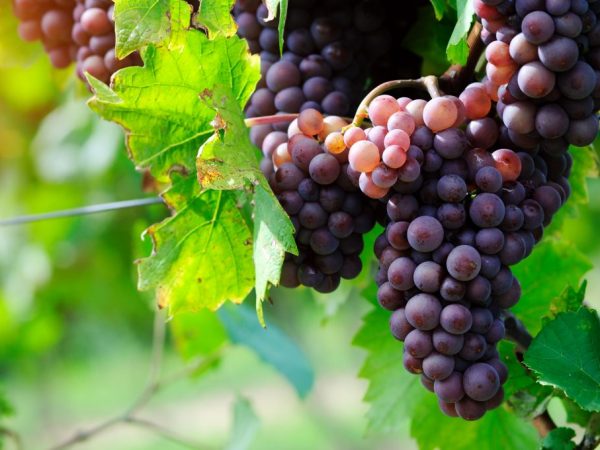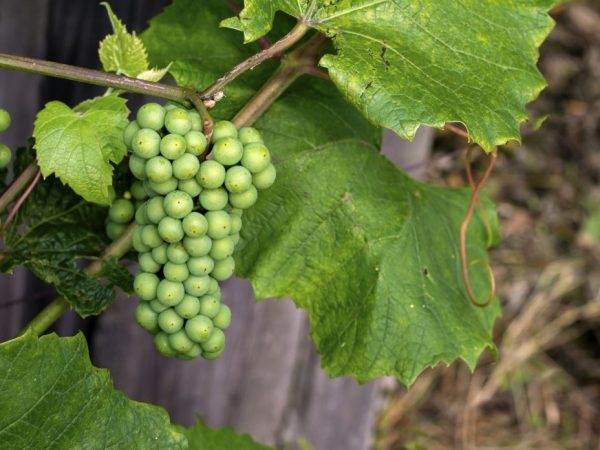Characteristics of the Garnacha grape variety
In Spain, only high-yielding crops with good taste are chosen for wine. These include the Garnacha grape variety. It produces rosé, mature wines. Its pulp contains little sugar, so it is suitable for children and people on a diet.

Characteristics of the Garnacha grape variety
Characteristics of grapes
The Garnacha grape is often blended with other varieties to produce the famous fortified Spanish and French sweet wines. In France it is called Grenache. The alcohol level is high. Combines several varieties.
It is a thermophilic species that tolerates drought and heat well. Garnacha has a long growing season, some berries do not ripen and fall off.
300 g contains only 210 kl. In juices, this figure rises several times due to glucose and fructose. Also, berries contain a large amount of vitamins A, B, K, PP and useful trace elements.
Even in dry climates, the bush yields 20 c / ha. It is wind resistant. The root system grows deep into the soil and takes root from the first weeks of planting. The frost tolerance of the culture is slightly lower than that of other representatives of the grape. At temperatures below -18 ° C, the plant begins to hurt and may die.
Varieties of varieties
- Grenache Noir - for making red wine;
- Grenache Gris - for making a pink drink;
- Grenache Blanc - white grapes give the wine a straw color.
All varieties require proper care and plenty of light. For planting, they choose only a warm climate without strong, cold winds.
Description of the bush and fruit
The bushes of the culture are vigorous, with strong branches and a stable trunk. Leaves are small, three-lobed, dark green in color.
On the one hand, the leaf of Grenache is shiny, on the other - rough, with a slight spiderweb pubescence.
A strong root allows you not to water the plant for a long time. The vine begins to bloom early. The bunches are medium-sized, conical in shape. Its berries are also not large with a dense skin, purple-pink or green. The pulp of the fruit is juicy and contains a lot of sugar. In Spain, berries are prized for their sweet, rich taste.
Growing grapes
To grow Grenache grapes, several points must be taken into account:
- The right choice of place and region is dry summers, warm winters. Plenty of sunshine.
- Plant in non-acidic, unsalted soil.
- Planting dates are autumn or spring.
- They are planted at a distance of 1.5 m from each other.
- With high humidity, the plant begins to ache and rot.
Before planting in open ground, the plant is fertilized, a hole is dug about 1 m deep. Drainage from sand, sawdust and fertilizer is placed at the bottom of the hole. After planting, the bush is watered abundantly.
Plant care

The plant needs to be well looked after
Crop care:
- The first watering is carried out in the spring using warm water. If it is necessary to suspend the growing season, watering is done with cold water. For 1 bush 200-300 liters.Winegrowers advise making drainage for irrigation - several holes with 7 cm diameter tubes per bush. The drainage method of irrigation is deeper.
- Loosening and mulching of the soil. So that the soil around the bush is not taken with a crust, it is mulched and loosened. For mulch, choose sawdust, dried grass, straw. Dig up the soil no deeper than 15 cm.
- Pruning. Forms the crown of the vine. Prune the vine in the fall, when the movement of the juices stops. And in the spring they do sanitary cleaning. Cutting dry shoots only. Remove the lower, diseased, cracked branches and new shoots.
- Shelter for the winter. In the early years, seedlings are covered in the winter. To do this, use a light cloth or plastic wrap. They remove the shelter at the end of spring, when the frost stops.
Together with the seedling, a support is placed in the hole to help the trunk to strengthen. You should constantly get rid of weeds around the plant. Pruning is done with pruning shears or garden shears (before this you need to disinfect). Cutting points are treated with potassium permanganate or paint.
Fertilizer
For culture, fertilizers are applied to the soil to stimulate growth or prevention, or spray the bushes with drugs. Top dressing for grapes should contain nutrients:
- nitrogen;
- phosphorus;
- potassium;
- copper;
- boron;
- zinc.
Fertilize in the spring. The first feeding is done after removing the shelter. To do this, mix 20 liters of water, 40 g of superphosphate, 20 g of ammonium nitrate and 10 g of potassium salt. The solution is enough for 2 bushes. After harvesting, spraying with chemicals is carried out:
- "Aquarin";
- "Novofert"
- "Solution";
- Florovit.
These are complex fertilizers that help restore the balance of nutrients in the vine sap. For feeding, droppings and a sugar-glycerin solution are often also chosen. For him, mix 100 g of sugar or 60 g of glycerin. The solution strengthens the outer foliage skin.
Diseases and pests
Garnacha's diseases:
- powdery mildew;
- anthracnose;
- mildew.
Diseases affect the leaves, shoots and berries of the plant. Mildew is treated with drugs: "Ditan", "Acrobat MC", "Orius", "Mankotseb" or "Tridex". To combat powdery mildew, choose "Bnomil", "Strobi" or "Impact". They are bred with water according to the instructions.
In addition to diseases, insects harm the plant:
- Spider mite. Nutrients are sucked out of the trunk, which leads to the death of the branches.
- Aphid. Small insects that eat foliage and fruits.
- Acacia false shield. A dark yellow insect that forms bulges on the trunks with its body. It makes the bush weak and it shrinks.
- Leafwig. Their caterpillar eats leaves, fruits. After which the foliage falls off, and the fruits are deformed.
Chemical preparations for combating leafworm and false shield:
- Fufanon-Nova;
- Aliot;
- Inta-Vir;
- "Decis".
Aphids will disappear after being treated with a solution of ash. To do this, 300 g of ash are boiled for 30 minutes in 10 liters of water, cooled and 40 g of soap is added. Acaricides are used against spider mites - neoron and omite. Plants are treated with preparations 2 times every 10 days until the insects are completely destroyed.
Conclusion
The Garnacha grape variety is a fruit with a thick skin and sweet pulp. Often exposed to diseases of powdery rose and mildew, if the amount of moisture in the soil is more than necessary. For cultivation, they choose warm regions with a dry climate. Refers to white and black grape varieties.


